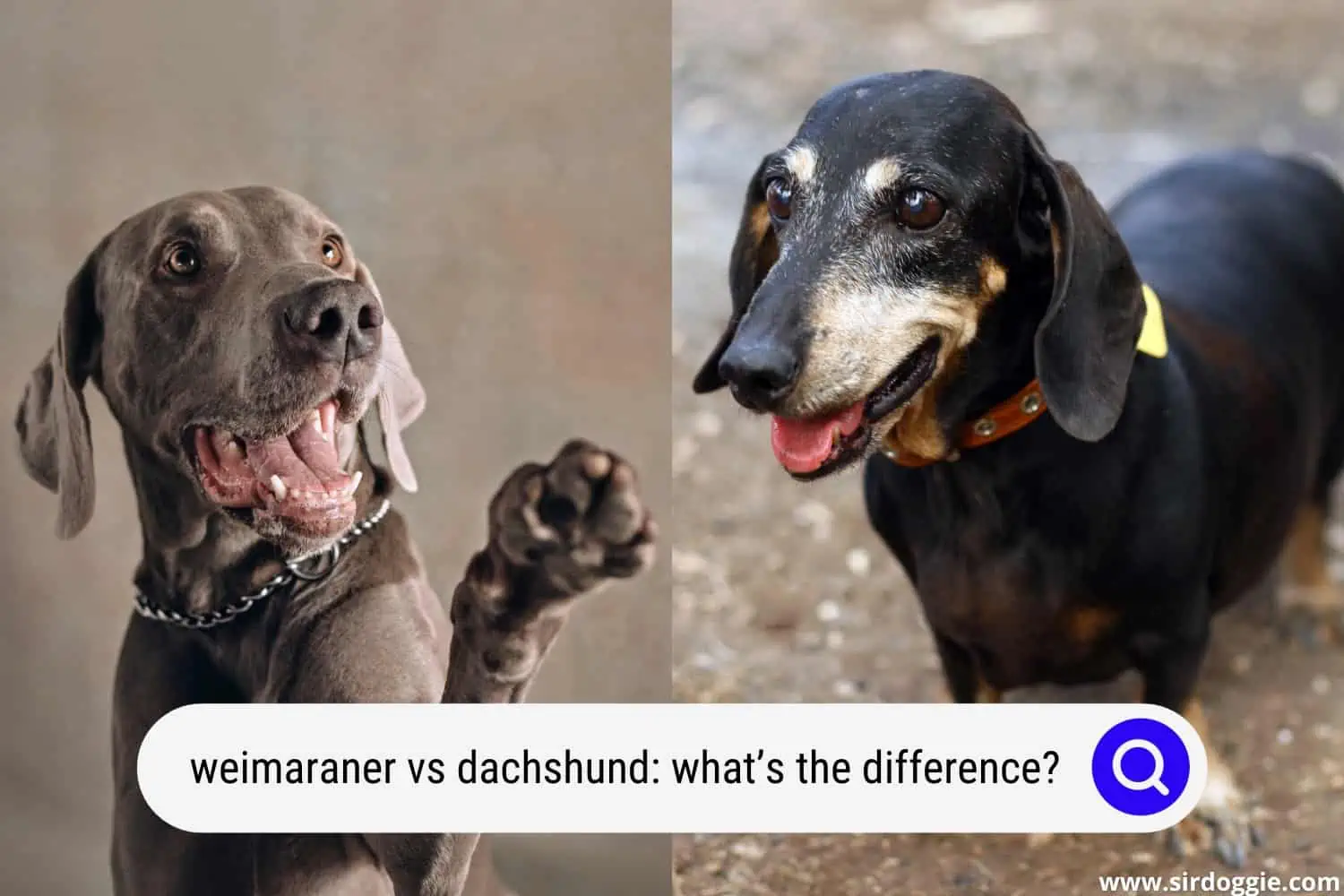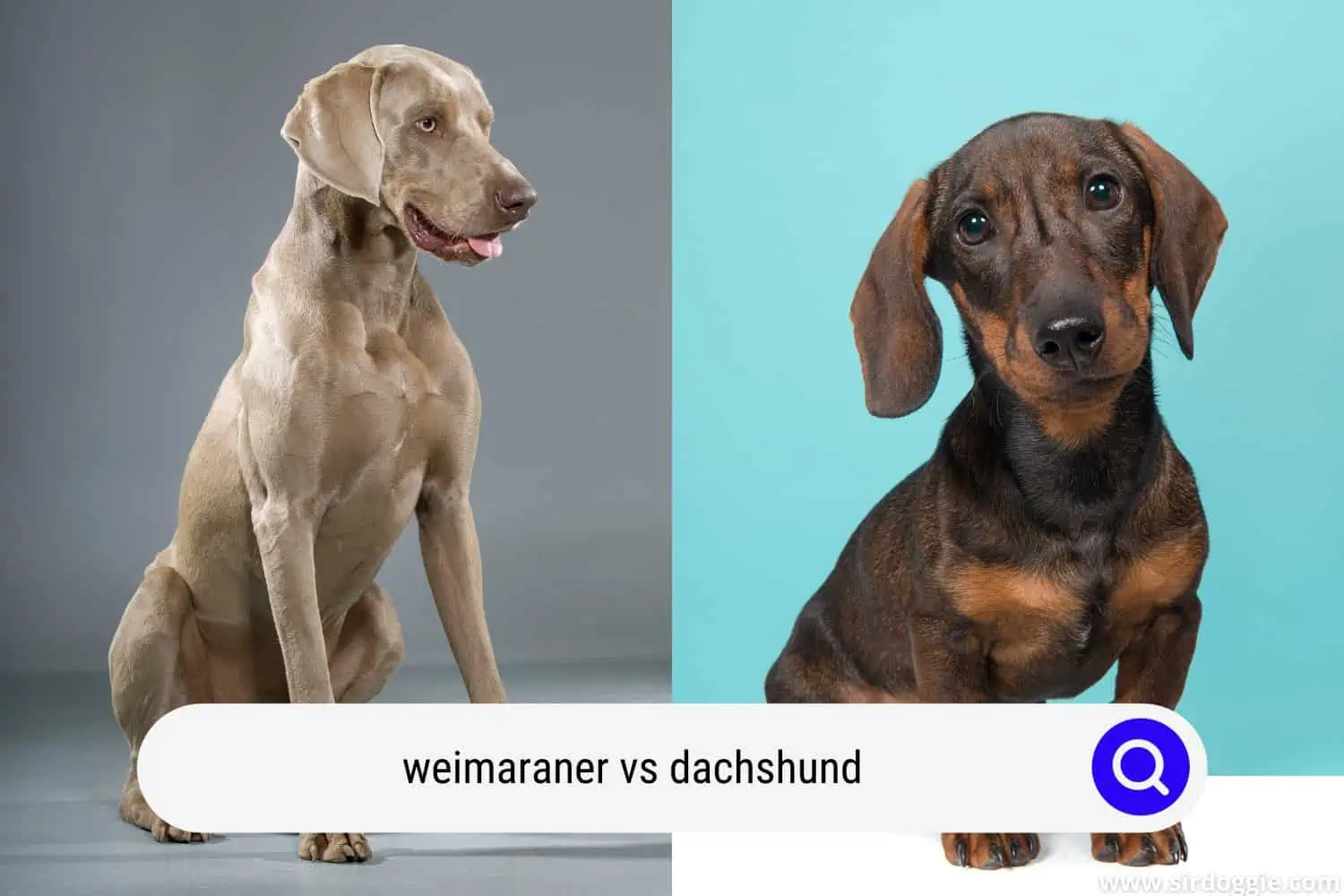Weimaraner vs Dachshund: What’s the Difference?
The Weimaraner and the Dachshund may seem like two opposites at first look. However, they have similarities and differences, which makes the task of choosing between these two more difficult.

Both the Dachshund and the Weim are very child-friendly, pet-friendly, and family-friendly. However, the Dachshund is usually not a friend to strangers and it barks often. But there is more to these breeds than the aforementioned.
In this Weimaraner vs Dachshund comparison article, we’ll take a look at the characteristics, temperament, origin, history, and health life of the two breeds so you can know which will be perfect for your lifestyle or work life.
Related Reading: A Complete Guide to the Weimaraner Pitbull Mix
Weimaraners
Weimaraners, from the first months of life, demonstrate pride and elegance that is truly out of the ordinary.
There are two versions of Weimaraners: the long-haired and the short-haired. Of German origins, they came to conquer the United States with strokes of sweetness. Enthusiasts have a soft spot for them and it is not difficult to understand why, they are also excellent hunting dogs and have many other skills.
It was precisely these aspects that prompted the Americans to raise them with particular attention. Officially they are continental pointing dogs.
Weimaraner: Origin and history
We owe the birth of the Weimaraner puppies to Grand Duke Carl August, who needed help during hunting sessions in the Thuringian forests. The name of these highly skilled breeds can be traced back to the Weimar court.
These four-legged friends could ideally be defined as globetrotters (obviously remaining in the context of origins). In fact, among their ancestors, we find the Gray Dog of Saint Louis. It was Louis IX who brought it to France and then to Germany, where it was mated with the Pointer. The first official club came in 1897, but only after two world wars did the official recognition of this truly extraordinary breed arrive.
Weimaraner: Physical appearance
From the first months of life, these four-legged friends show that they have a truly extraordinary nose.
Once they reach adulthood, they become medium-large. At the withers, they measure from 60 to 65 centimeters, for a weight that is around 30/40 kilos. The bitches, however, are a little smaller than the males and do not exceed 35 kilos.
The body is overall elongated and with a lean and well-developed musculature, to rival the best athlete on the square. The tail is often cut, but now it is an illegal practice in many countries.
What could leave you speechless is the amber look: magnetic and intelligent. Not to mention, then, that the puppies have a pair of sky-blue eyes that conquer.
Weimaraners are also known for their coat color. One of the reasons they are so elegant and regal is this.
Weimaraner: Temperament
Here, we have a four-legged friend with a protective and very sweet nature. It manages to create a truly extraordinary bipedal-quadruped relationship.
They bond with all members of what they consider to be their own family. They show such loyalty as to confirm the saying the dog is man’s best friend and are also fond of the little ones. Also, the icing on the cake – even if they are born as hunting dogs – they are valuable supports when it comes to guarding.
Although they are very sweet, they are also very proud and need to start training sessions earlier than other breeds. If you do not train them properly, they may grow suspicious of those they do not know.
The Weimaraner was used not only as a hunting dog but it as an aid for civil protection. It is one of the best in the search and rescue fields.
Weimaraner: Health
This breed often suffers from diseases such as stomach torsion (which, if not diagnosed and treated in time, can be fatal) and hip dysplasia (which often affects German Shepherds too).
The Dachshund
The Dachshund, also known as “Deckel” or “Teckel”, is perhaps one of the best-known breeds recognized by the FCI.
It stands out for its short limbs and elongated body. These not only give it its characteristic name but also make it very popular with children (due to its curious shape).
But it is not only the little ones who appreciate this breed that has an affectionate character. Thanks to the tenderness of its appearance, the Dachshund is a dog that can conquer most adults.
Dachshund: Origin and history of the breed
The Dachshund is a dog that boasts of a particularly ancient history. Its origins date back to the times of Ancient Egypt, given the discovery of hieroglyphs and engravings depicting dogs with very short legs.
To confirm these theories, there is some recent research conducted by the American University of Cairo, which would have found the remains of mummified animals similar to dachshunds inside ancient funeral urns.
In reality, the Dachshund we are used to today is due to the research work of German breeders, who have tried to combine the characteristics of both German, English, and French hounds and terriers.
The intent was to be able to have a dog that could be used to track down badgers around the Royal Courts or in hunting grounds, which would also explain its original name “Dachshund”, born from the combination of the terms “Dachs” – badger – and “Hund” – dog.
In any case, the first news relating to this dog breed appears in some books of the eighteenth century, when the dog is defined not only by the purpose for which it is used but also by its physical characteristics.
Some say that the origin of this dog is in the fifteenth century. Others say it’s at the turn of the nineteenth and twentieth centuries. But what really matters is knowing that the modern Dachshund is linked to recent breeding, and not to the dogs of the Ancient Egyptians.
Dachshund: Character
By nature, the Dachshund stands out for being a dog with an excellent temperament. Friendly, lively, and playful, it is an animal that shows great affection towards the family in which it lives, and above all the person it recognizes as the leader of the pack.
Its playful character makes it a dog well suited to life with children. You should however keep the Dachshund under control when it’s playing or with the little ones. If overexcited, it can have slightly aggressive behavior.
Finally, the Dachshund is an active dog, who loves being outdoors, running, and having fun. This means that it does not adapt at all to owners looking for a breed with a sedentary lifestyle.
By nature, it is particularly demanding especially as regards its training. It is usually very stubborn and impulsive.
Dachshund: Physical characteristics
The characteristics of the Dachshund include being short, stocky, and wrinkled. They have a solid bone structure and powerful muscles. Despite the very small limbs, the dog’s gait does not appear awkward or heavy at all.
The body of the Dachshund is elongated, with the top line slightly inclined: the chest is broad and deep, while the belly is retracted.
The weight of the Dachshunds must never exceed nine kilos. As for the height, it is not much considered. The measure that really matters, for the size of the breed, is that of the chest circumference taken at one year of age.
The head is elongated, but with a tendency to narrow towards the nose, which is dry, chiseled, and with well-opened nostrils.
The bridge of the nose is slightly arched. The stop is not particularly marked and the eyes are oval and of medium size, with colors that can vary between the different shades of brown.
The ears are set high, slightly tilted back: they are flat, with a rounded tip, and with the front side practically in contact with the cheek.
The tail is set rather high as if it were an extension of the dorsal line: it is long, thin, pointed at the end, and covered with hair.
Among the most common colors are the fawn or black and tan in the short hair, the boar color in the wire-haired, and the mahogany red in the long hair.
Beyond these, the most popular Dachshund colors in recent years are chocolate, harlequin (dark background with light spots), brindle, and two-tone.
Dachshund: Health
In general, the Dachshund is a dog that enjoys good general health and boasts remarkable longevity, so much so that it can live up to 16 years (and even beyond, in some cases).
The dog tends to gain weight, a characteristic of the breed. You will therefore need to know how to balance good nutrition with the right amount of physical activity, to prevent your Dachshund from gaining weight beyond limits.
Among the other pathologies that the dog could suffer from are: luxating patella, epilepsy, glaucoma, hyperthyroidism, and progressive retinal atrophy.
Weimaraner vs Dachshund Comparison Table:
| Dachshund | Weimaraner | |
| Size | 8 to 9 inches | 23 to 27 inches |
| Coat | Smooth, long, wirehaired | short and long (in the two types) soft, dense, smooth, without undercoat |
| Origin | Germany | Germany |
| Lifespan | 1 to 16 years | 1 to 14 years |
| Colour | Black, black and tan, chocolate and cream, cream, blue and tan | Silver or mouse gray |
| Common diseases | luxating patella, epilepsy, glaucoma, hyperthyroidism, progressive retinal atrophy. | allergies, hip dysplasia |
| Character | stubborn, clever, devoted, courageous, lively, playful | intelligent, energetic, fearless, obedient, intelligent, alert |
| Price | $800 to $1500 | $500 to $1500 |

Conclusion
The Dachshund is a good choice for inexperienced and new owners while the Weimaraner may not be suitable for inexperienced owners but it will be great for new owners.
Both of the breeds are friendly to children but the Dachshund is friendlier. Maintaining both breeds requires less effort, expense, and time but grooming the Weim is easier. While the Weimaraner barks minimally, the Dachshund barks frequently.

Family Dog Expert Author
Hi there! I’m Stuart, a devoted dog lover and family dog expert with over a decade of experience working with our furry companions. My passion for dogs drives me to share my knowledge and expertise, helping families build strong, loving bonds with their four-legged friends. When I’m not writing for SirDoggie, you’ll find me hiking, playing with my beautiful dog, or studying music.